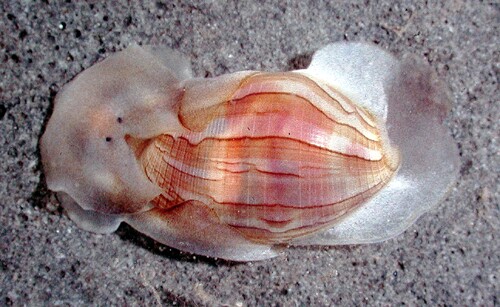| Home |
| Acknowledgments |
| Conventions |
| Glossary |
| Maps |
| References |
| Links |
| Articles |
| Thumbnails |
| Species
list |
| Family |
| Next
species |
Additional Photos

underside

young

transitional

shell

probable egg mass
_______________
GALLERY

Atys kuhnsi Pilsbry, 1917

| Maximum size: 30 mm
(extrapolated from shell length). Identification: This species has a thin, strongly inflated shell with a thin, brown periostracum. The periostracum is uniform and faint while young but develops dark axial streaks as the animal approaches maturity. The shell is widest at the midline. Very young shells (1-2 mm) have wavy spiral striae over the entire shell. During growth, the wavy striae are replaced by crisp striae on the apex and base which gradually "expand" to cover the entire shell when fully mature. The animal is cream frosted with brown and white flecks and with large pink patches that show through the shell when young. Young animals can be distinguished from Atys semistriatus by the profile of the shell, the larger eye spots and the larger pink spots showing through the shell. Natural history: Atys kuhnsi is a moderately common species that can be found in Halimeda kanaloana beds or mixed habitats at depths of 5-31 m (16-102 ft). Dredged shells at the Bishop Museum extend the depth range to at least 82 m (269 ft). It is nocturnal in habit and buries itself in the sand during the day. Spherical, sand-anchored, white egg masses seen in the field in Halimeda kanaoalana beds (much larger than those laid by Aliculastrum debile) are probably laid by this species but that has yet to be confirmed with captive animals. Distribution: Big Island, Maui, Oahu, French Frigate Shoals and Midway: may be more widely distributed in the Indo-Pacific if animals currently considered juvenile Atys naucum from elsewhere are actually this species. Taxonomic notes: This species is often treated as a synonym of Atys naucum (Linnaeus, 1758) and is listed as A. naucum in Severns, 2011. However, the Hawaiian animals lack the white and black marginal bands on the parapodia found in mature specimens of that species. It also appears likely that at least some axially streaked shells from elsewhere in the Indo-Pacific will turn out to be this species rather than juveniles of the banded animals illustrated as mature A. naucum in various sources. It was first reported from Hawaii in Pilsbry, 1917. The photo labelled Atys semistriata in Kay & Schoenberg-Dole, 1991 is probably this species, instead. Photo: CP: Wahikuli Park, Maui; Oct. 25, 1995. Observations and comments: Note 1: ( ) |
| Thumbnails |
Species
list |
Family | Next species | Top |